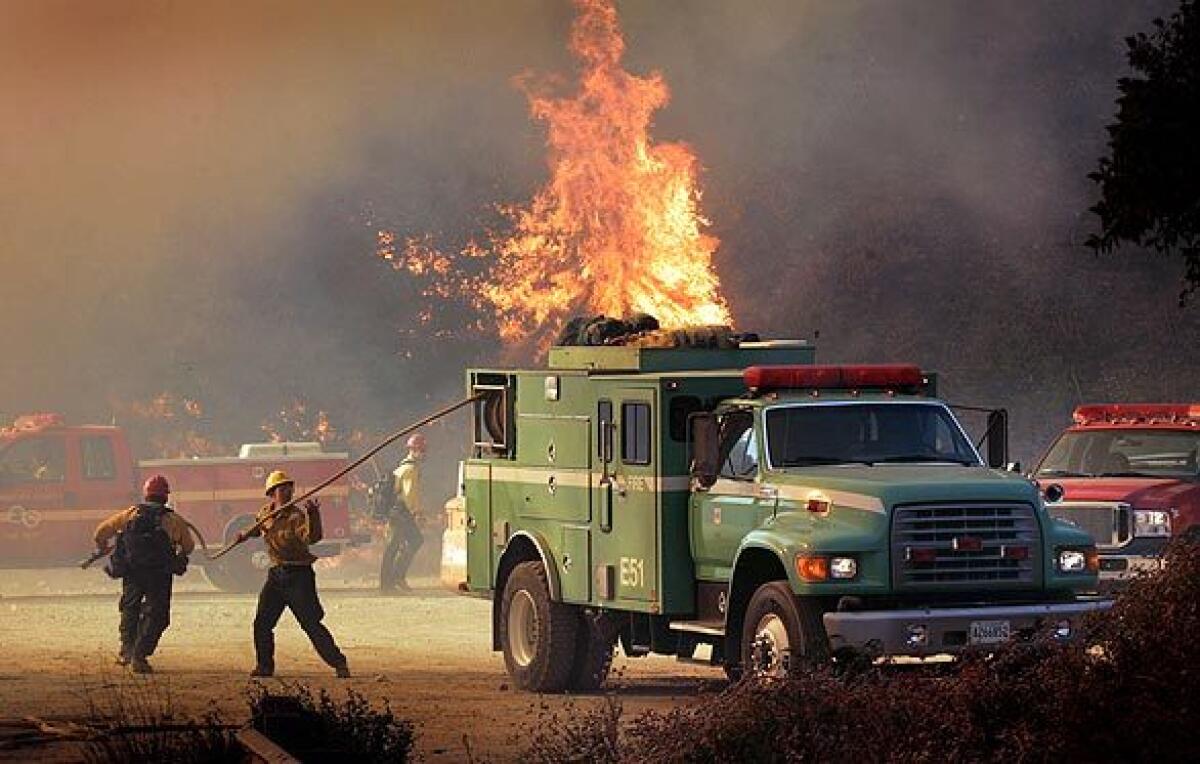Former Forest Service officials want a wider probe of the Station fire

A group of former U.S. Forest Service officials is calling for a new and independent investigation into the agency’s handling of last year’s devastating Station fire, with many contending that an internal inquiry completed in November ignored critical missteps.
That probe by the Forest Service’s Washington, D.C., headquarters found no tactical errors in the initial attack on the fire. And in a key conclusion, it blamed hazardous terrain for the lack of a heavy air assault early on the fateful second day, when the blaze began to race through the Angeles National Forest.
“I didn’t think that conclusion was even close to being correct,” said Larry Boggs, a former fire management officer who worked for the Forest Service for 31 years, 13 of them in the Angeles. “It was a whitewash. Aircraft would have been quite effective on the fire that day.”
Many of the two dozen retired officials asking for the investigation held prominent positions in the Angeles and in the Forest Service’s regional and national offices, said an organizer of the group, William Derr, a former special agent in charge of the Forest Service’s law enforcement arm in California. Many remained active in fire protection for years after their retirement in a variety of consulting, contracting and teaching jobs, Derr said.
After learning of the calls for another inquiry, Rep. Adam Schiff (D-Burbank) told The Times that he plans to convene a panel of Los Angeles-area House members to take testimony here, including from the retirees.
“We can have a full airing of the issues that have been raised,” said Schiff, who also has urged Congress to require the Forest Service to consider ending a practice that bars its firefighting aircraft from flying night missions.
Forest Service officials said they would welcome the Schiff hearings. “We’ve got nothing to hide,” said Angeles Forest Supervisor Jody Noiron.
The retirees said a second Station fire review should look at whether the Forest Service generally has become less aggressive in attacking wildland blazes and had been hobbled by an exodus of managers with firefighting expertise.
“This is the most highly protected watershed anywhere, certainly in the United States,” Troy Kurth, a former fire prevention officer for the California region, said of the Angeles. “What were the factors that led to this fire’s escape? . . . I just can’t come to the same conclusions as the Forest Service did.”
The Station fire was the largest in Los Angeles County history, scorching about 250 square miles and destroying scores of dwellings. Two county firefighters were killed on its fifth day, Aug. 30, while trying to defend their mountaintop camp from towering walls of flame.
Some of the retirees compared the Forest Service report unfavorably to a county Fire Department review of the circumstances surrounding the deaths of Capt. Tedmund Hall and Specialist Arnaldo Quinones. The review acknowledged that poor communications by commanders contributed to the tragedy. “A very well written county report,” Kurth said.
Citing records and interviews, The Times reported last fall that the Forest Service had misjudged the threat posed by the fire and missed an opportunity to contain the flames early on Day 2, in part through a bigger air assault.
The paper also reported that the Forest Service had issued a memorandum three weeks before the fire instructing supervisors to cut costs by limiting the use of reinforcements from other agencies.
Forest Service officials say costs did not influence their decisions on the Station fire.
The retirees began a behind-the-scenes lobbying campaign for a rigorous review in October, making their case through e-mail exchanges, telephone calls and meetings with Forest Service administrators, said Derr, who wrote several letters to the agency asking for the fuller investigation. Even after those requests were rejected, Derr said, he and other retirees were reluctant to go public because of an enduring loyalty to the Forest Service.
“An independent, comprehensive inquiry is essential to gather all the facts so that future fires can be safely and more effectively fought,” he added. “The November report was incomplete and flawed.”
Doug Leisz, the former associate chief of the Forest Service, was less harsh but said the report “missed some things.”
“I would still go back and talk to all the people who were involved,” he said. “I wouldn’t say, ‘Who screwed up?’ I’d say, ‘How could we do it better next time?’ ”
Mike Rogers, the former supervisor of the Angeles, said informal attempts to persuade Forest Service officials to take a fresh look at the Station fire were “kind of blown off.”
Rogers said some Angeles employees are afraid their careers would suffer if they criticize their superiors, “so there needs to be some kind of review where people’s anonymity is protected.”
Meanwhile, Noiron said that a reexamination of dispatch and equipment records showed that an order for three air tankers early on the second day of the fire had not been canceled, as previously released documents indicated.
Instead, she said, the planes were delayed because their flight crews had not been rested for the mandatory number of hours after working on another blaze the day before.
A Station fire commander had ordered the air tankers to be over the flames at 7 a.m.; they did not begin arriving until around 9 a.m., according to the records. During that two-hour interval, the fire grew exponentially, jumped a crucial defense line along Angeles Crest Highway and started to rage of control.
Don Feser, who retired as Angeles fire chief in 2007, said, “If their pilots couldn’t meet that time frame, why didn’t the commanders do something about it?”
Feser said lingering questions about the aircraft could be cleared up only through another, wider inquiry: “It all comes down to interviewing the right people and getting the total story out.”
--
More to Read
Sign up for Essential California
The most important California stories and recommendations in your inbox every morning.
You may occasionally receive promotional content from the Los Angeles Times.











